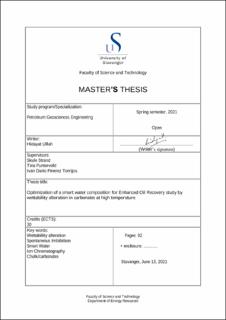| dc.description.abstract | Seawater due to its wettability modifying qualities has proved to be an excellent injection fluid in
chalk. At high temperature seawater alter wettability towards more water-wet conditions thus
improving the overall oil displacement by spontaneous imbibition into the chalk matrix. Smart
Water is that injection brine which is specifically design to alter the wettability of reservoir towards
the more water-wet state. Such kind of Smart Water needs to be abundant in concentration of some
ions like Ca2+, SO4
2-, and Mg2+.
In this research, finding efficient Smart Water’s composition, concentration, and stable
equilibrium are aimed. Stevns Klint Chalk cores used for their analogy importance to Ekofisk.
Experiment temperature is also chosen as reservoir temperature of Ekofisk (130 ºC) to provide a
better resemblance to reservoir conditions.
Three cores were cleaned with de-ionized water, restored 10% Swi with sulfate-free formation
water, and 90% Soi with oil with AN equal to 0.53 mg KOH/g. After that, two types of Smart
Water i.e. Smart Water-1 (SmW-1) having composition of CaSO4 (20mM) and MgCl2 (20mM)
and Smart Water-2 (SmW-2) having composition of CaSO4 (20mM) and MgCl2 (40mM) were
prepared. Core No. 1 was spontaneously imbibed (SI) with Formation Water (FW) in secondary
mode. SmW-1 was SI in tertiary mode and in secondary mode with Core No. 1 and Core No. 2
respectively while Core No. 3 was SI with SmW-2 in secondary model.
The results of spontaneous imbibition of Core #1 with FW confirms an ultimate recovery of 34
%OOIP reached after 4 days. Ultimate recovery of 55.5 %OOIP was reached by Core No. 1 after
43 days by SI of SmW-1 in tertiary mode. Core No. 2 reached ultimate recovery plateau of 66.1
%OOIP while Core No. 3 had an ultimate recovery plateau of 53.8 %OOIP in secondary mode.
Comparison of these results with Tahmiscioglu (2020), Andreassen (2019) and Lindanger (2019)
shows that SmW-1 had more ultimate recovery of oil due to better alteration of wettability towards
water-wet conditions than the Smart Water and Sea Water used by these other researchers. | |
